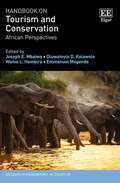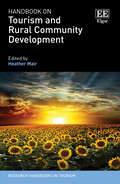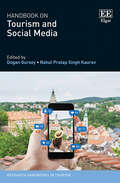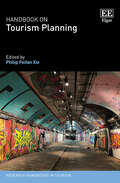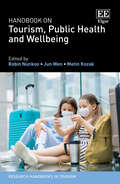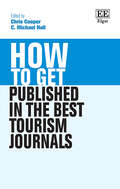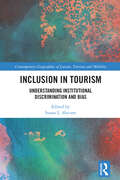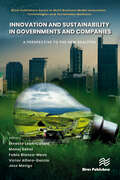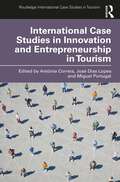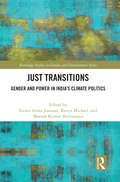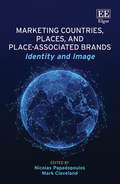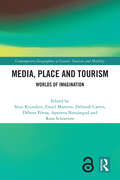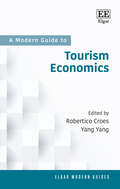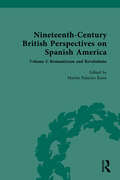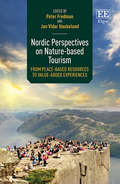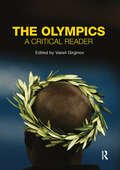- Table View
- List View
Handbook on Tourism and Behaviour Change (Research Handbooks in Tourism series)
A must-read for researchers and practitioners focusing on how the tourism industry needs to evolve given the societal and sustainability challenges we face, this comprehensive Handbook serves as a vital reference point for advanced research in tourism and behaviour change. Chapters depict critical reviews and debates on the topic, comprising both theoretical and empirical research illustrated by international case studies to explore strategies for current and future challenges in the field.The Handbook explores why, while there is heightened debate surrounding the negative impacts of tourism, people tend to be psychologically distant from this problem when they travel, and greater efforts need to be made to encourage people to be socially and environmentally responsible. Leading contributors from across the globe show how and why tourists’ and residents’ behaviour change interventions need to be designed to align with the Sustainable Development Goals going forward, and how a thorough understanding of tourism settings is key to achieving desired behaviour change outcomes.With the COVID-19 pandemic encouraging a resurgence of interest in the topic, this timely Handbook will be a key resource for tourism scholars and students. The explorations of why behaviour change is important and when to implement interventions that are offered across the chapters will also be beneficial to tourism practitioners and policy makers.
Handbook on Tourism and Conservation: African Perspectives (Research Handbooks in Tourism series)
The Handbook on Tourism and Conservation demonstrates the intrinsic nexus between tourism, the environment and sustainable natural resources use. It applies Ostrom’s social-ecological systems (SESs) theory as the analytical framework for reaching a consensus on divergent viewpoints within the context of global environmental change and emerging governance issues.Reflecting the interdependency between tourism and biodiversity conservation, the book focuses on four thematic areas. These include tourism and conservation in protected areas; tourism and climate change; sustainable agritourism; and destination communities and natural resources conservation. Thus equity and environmental justice issues are highlighted in relation to how destination communities have benefitted from tourism activities. The Handbook will be a useful guide for policymakers and relevant institutions in the implementation of tourism policies that balance issues in tourism and environmental conservation equally and which in turn could enhance wider participation in tourism development by all stakeholders in the sector.The Handbook will be a valuable resource for academics, researchers and students of tourism studies, geography, environmental policy, management and related fields. It will also be beneficial for sustainable tourism policymakers and planners.
Handbook on Tourism and Rural Community Development (Research Handbooks in Tourism series)
This Handbook brings together experts from around the world to reflect critically on the relationship between tourism and rural community development. It first orients the reader in the important conceptual and epistemological foundations of the topic, before moving to consider key concepts and the most significant and salient theoretical and methodological developments in the field.Chapters written by a range of well-established, leading and emerging scholars in the field consider crucial issues facing tourism development in rural communities across different geographical settings. The Handbook represents a variety of traditional and emerging forms of scholarly writing, including theoretically driven chapters, empirical case studies and first-person narratives, to offer a detailed study of the topic. With a forward-looking angle, it studies tourism development in rural areas, including working with rural communities, tourism governance and ethical considerations. Chapters also consider new directions in the field, examining food and tourism, degrowth, landscapes, animals, social impacts and women social entrepreneurs.This comprehensive and innovative Handbook offers a wealth of empirical and theoretical knowledge on tourism and rural community development, and as such will be a critical resource for tourism, development studies and human geography scholars and students.
Handbook on Tourism and Social Media (Research Handbooks in Tourism series)
This comprehensive Handbook offers an overview of current research on the use of social media within the tourism industry, investigating a range of social media practices and proposing strategies to address key challenges faced by tourist destinations and operators. International contributors analyse both conceptual and practical social media topics, addressing cutting-edge social media issues in destination management and marketing. Drawing on empirical case studies and examples, chapters explore dark tourism, gastro-tourism, travel blogs, electronic word-of-mouth, sentiment analysis and a variety of quantitative and qualitative methodologies. The Handbook also defines central social media concepts and explores the impact they have on the success of tourist destinations, setting the stage for a better understanding of the relationship between social media and tourism. Through an examination of current trends in social media, as well as future trajectories, it provides critical insights for the successful development and implementation of social media marketing strategies. This Handbook will be a critical read for scholars and students of geography and business management, with a specific interest in tourism and hospitality management. Its practical considerations will also be beneficial for planners, policy makers, managers and marketers in the tourism industry.
Handbook on Tourism Planning (Research Handbooks in Tourism series)
Timely and accessible, this Handbook offers a thorough account of the growth, development, and changes in the field of tourism planning over recent decades. With contributions from an interdisciplinary and international range of top scholars, it examines critical issues and challenges facing contemporary tourism planning.Covering research at local, national, and global levels, chapters unpack and frame planning strategies in various destinations, expanding the definition of tourism planning to encompass a range of successful case studies. The Handbook looks at reimagining tourism planning through sustainability; engaging with forms of creative cultural tourism, the smart city, and rethinking how we see, communicate, understand, and can transform tourist destinations. It also highlights how the COVID-19 pandemic has intensified pre-existing issues in the tourism sector, including sustainability, policy, and governance.Providing both theoretical and practical perspectives on tourism planning, this Handbook is an essential reference for students and scholars in the field. The diversity of perspectives and action-oriented, project-specific approach also make this an invigorating read for tourism planners and practitioners, particularly those focusing on making tourism practices more sustainable.
Handbook on Tourism, Public Health and Wellbeing (Research Handbooks in Tourism series)
In a time of rapid change for travel-related health interventions, this timely Handbook offers critical insights into the interrelationship between tourism, public health, and the wellbeing of local communities and tourists. Written with a global audience in mind, it features cutting-edge interdisciplinary research conducted by leading academics in tourism, public health, wellbeing, and social welfare. Investigating the nexus between tourism and public health in an era of globalisation, tourism growth and COVID-19, this incisive Handbook rethinks the role of tourism in contemporary society. Chapters explore issues from medical tourism, spiritual health, and sustainability to wellness, social development, and disease outbreaks, providing key insights that will assist diverse stakeholders to better navigate this uniquely challenging time in travel and health promotion. The Handbook addresses the growing risks of international travel and considers how the tourism industry might evolve in the wake of COVID-19 and other crises afflicting modern society. Cross-disciplinary in scope, this dynamic Handbook makes a crucial contribution to the literature on the consequences of tourism for public health. Its novel analyses of topics related to tourism, public health, wellbeing, and social welfare will be of significant benefit to tourism stakeholders, healthcare practitioners and policymakers.
How to Get Published in the Best Tourism Journals (How To Guides)
Drawing on a wealth of knowledge and experience from leading tourism academics and journal editors, this practical How To guide offers clear-sighted advice on how to craft a high-quality paper in terms of contribution, positioning and submission. Accessible and comprehensive, it demystifies the process of getting published in the top tourism journals.This insightful book begins by mapping out the tourism publishing landscape, before delving into the various methods of building a refereed journal paper and navigating tourism publishers. Chapters dissect contemporary publishing issues, including gender inequality, ethics and integrity, and the dominance of English language publishing. Finally, contributors outline the essential role of publishing in shaping an academic career in tourism, especially in securing jobs, obtaining grant funding and creating pathways for career progression.How to Get Published in the Best Tourism Journals offers an insider perspective and practical advice while posing questions about the future of tourism publishing in the light of developments such as AI and Open Access. It will prove an essential resource to enhance journal publication success for tourism PhD students, as well as tourism academics at all career stages.
Inclusion in Tourism: Understanding Institutional Discrimination and Bias (Contemporary Geographies of Leisure, Tourism and Mobility)
Inclusion in Tourism provides examples of discrimination and marginalisation in tourism practices and avenues designed to recognise and overcome personal or institutional biases, setting a road map for researchers interested in establishing a more inclusive approach to tourism and tourism research. Logically structured, multidisciplinary in approach, and compiled by a well-known scholar and leader in tourism theory, this volume comprises 13 specially commissioned chapters that provide concrete global examples of overcoming discrimination within tourism institutions, centred around examples of best practice, courses of action, and positive outcomes. Chapters outline, explain and challenge the existing view of tourism theory as inclusionary, destroying the myth that tourism is an equal opportunity endeavour, bringing a new level of scrutiny to "stand-alone" concepts of "discrimination" and "marginalisation" as a long-existing phenomenon in tourism studies. The book begins with an institutionalised and global approach to discrimination, focusing on immigration policy, academic teaching, research, grant policies, and destination image in relation to minorities; and xenophobia. The text then moves to the individual level, discussing aspects of institutionalised discrimination based on individual characteristics, such as sexual orientation, obesity, disability, and gender. International in scope, this book will be of pivotal interest to graduate students, researchers, and practitioners interested in diversity and inclusion.
Innovation and Sustainability in Governments and Companies: A Perspective to the New Realities (River Publishers Series in Multi Business Model Innovation, Technologies and Sustainable Business)
Innovation and sustainability are issues that have become very relevant in recent years. This book presents a compilation of investigations on these topics, divided into those applied in government or enterprises. The objective is to demonstrate to the audience how these issues have been worked around the world and in different scenarios. Among the papers, there are works related to economic variables, imports, exports, and analysis in different sectors such as tourism, agriculture, education, and even in countries in general.
International Case Studies in Innovation and Entrepreneurship in Tourism (Routledge International Case Studies in Tourism)
This international case study book provides 23 expertly curated case studies on entrepreneurship and innovation in tourism, each with detailed implementation instructions for the instructor to maximise student participation and learning.The dynamic characteristic of the tourism industry under the influence of micro and macro environment factors requires future professionals to be equipped with appropriate skills and competencies to deal with change and development in real-life practices. Curated and developed by industry experts and practitioners, these case studies embody real-world scenarios with the aim of best preparing students for their future careers. This compelling set of case studies explores the dynamics of entrepreneurship in global context, analyses emerging markets and new business models, and elicits the implications of innovation and entrepreneurship in different contexts and within a transdisciplinary perspective. The cases illustrate innovation and entrepreneurship as an accelerator of tourism growth and development, under a sustainable perspective.With reflective questions throughout to aid both in-class discussion and self-study, this book is an ideal study resource for use in higher and vocational education, and its unique, teaching-led approach positions it as a vital study tool for instructors and students alike.
International Space Station (Large Print)
This is an image of the ISS, a very large man-made satellite orbiting the Earth at a height of 350 kilometres. There is a locator dot shown, which will be at the top left of the page when the image is the right way up. The station is used mainly for scientific research and although originally built by Russia and America, it is now manned by representatives of fourteen nations. In the centre of the page are the modules used for living and scientific research. These are attached one to another and reach the top of the page with the topmost one used as a dock for the Space Shuttle. Two rectangular solar panels extend out to the left and right of the modules. Down the page from these is the main truss running across the page. This supports two much larger panels on the far left and right of the page. Just to the left of centre, on the main truss, there is the mobile servicing system, which runs on rails, has two robot arms and is used for various construction and servicing tasks. To give an idea of the size of the structure, a scale image of a person in a space suit (approximately 6 mm high) is shown at the top centre of the page, just to the left of the research modules. The space station is constantly being changed and added to, so this diagram can only give an approximate impression of its layout.
International Space Station (UEB Contracted)
This is an image of the ISS, a very large man-made satellite orbiting the Earth at a height of 350 kilometres. There is a locator dot shown, which will be at the top left of the page when the image is the right way up. The station is used mainly for scientific research and although originally built by Russia and America, it is now manned by representatives of fourteen nations. In the centre of the page are the modules used for living and scientific research. These are attached one to another and reach the top of the page with the topmost one used as a dock for the Space Shuttle. Two rectangular solar panels extend out to the left and right of the modules. Down the page from these is the main truss running across the page. This supports two much larger panels on the far left and right of the page. Just to the left of centre, on the main truss, there is the mobile servicing system, which runs on rails, has two robot arms and is used for various construction and servicing tasks. To give an idea of the size of the structure, a scale image of a person in a space suit (approximately 6 mm high) is shown at the top centre of the page, just to the left of the research modules. The space station is constantly being changed and added to, so this diagram can only give an approximate impression of its layout.
International Space Station (UEB Uncontracted)
This is an image of the ISS, a very large man-made satellite orbiting the Earth at a height of 350 kilometres. There is a locator dot shown, which will be at the top left of the page when the image is the right way up. The station is used mainly for scientific research and although originally built by Russia and America, it is now manned by representatives of fourteen nations. In the centre of the page are the modules used for living and scientific research. These are attached one to another and reach the top of the page with the topmost one used as a dock for the Space Shuttle. Two rectangular solar panels extend out to the left and right of the modules. Down the page from these is the main truss running across the page. This supports two much larger panels on the far left and right of the page. Just to the left of centre, on the main truss, there is the mobile servicing system, which runs on rails, has two robot arms and is used for various construction and servicing tasks. To give an idea of the size of the structure, a scale image of a person in a space suit (approximately 6 mm high) is shown at the top centre of the page, just to the left of the research modules. The space station is constantly being changed and added to, so this diagram can only give an approximate impression of its layout.
Just Transitions: Gender and Power in India’s Climate Politics (Routledge Studies in Gender and Environments)
This book turns critical feminist scrutiny on national climate policies in India and examines what transition might really mean for marginalized groups in the country. A vision of “just transitions” is increasingly being used by activists and groups to ensure that pathways towards sustainable futures are equitable and inclusive. Exploring this concept, this volume provides a feminist study of what it would take to ensure just transitions in India where gender, in relation to its interesting dimensions of power, is at the centre of analysis. With case studies on climate mitigation and adaptation from different parts of India, the book brings together academics, practitioners and policymakers who provide commentary on sectors including agriculture, forestry and renewables. Overall, the book has relevance far beyond India’s borders, as India’s attempt to deal with its diverse population makes it a key litmus test for countries seeking to transition against a backdrop of inequality both in the Global North and South. This volume will be of great interest to students and scholars of climate policy, gender studies, sustainable development and development studies more broadly.
Lifeboat (Large Print)
The lifeboat is viewed from the side with its front or bow on the left of the page and the rear or stern on the right. There is a locator dot shown, which will be at the top left of the page when the image is the right way up. The lifeboat has two sections; the bottom section is the hull which would be in the water and the upper section is the cabin superstructure. Where these sections meet is the deck, which has handrails running along its entire length except for two gaps, one in the middle and one near the stern. These gaps are where the crew step aboard. In the middle of the cabin superstructure there are two rows of windows. The captain's bridge has one of its windows on the left of the upper row of five windows. Up from the windows is the boat's navigation light and then the lookout station. Two tall aerials stick up at the front and back of the lookout station, with the radar supported on two poles between them. Hand railings run to the right of the lookout station and down to the stern.
Lifeboat (UEB Contracted)
The lifeboat is viewed from the side with its front or bow on the left of the page and the rear or stern on the right. There is a locator dot shown, which will be at the top left of the page when the image is the right way up. The lifeboat has two sections; the bottom section is the hull which would be in the water and the upper section is the cabin superstructure. Where these sections meet is the deck, which has handrails running along its entire length except for two gaps, one in the middle and one near the stern. These gaps are where the crew step aboard. In the middle of the cabin superstructure there are two rows of windows. The captain's bridge has one of its windows on the left of the upper row of five windows. Up from the windows is the boat's navigation light and then the lookout station. Two tall aerials stick up at the front and back of the lookout station, with the radar supported on two poles between them. Hand railings run to the right of the lookout station and down to the stern.
Lifeboat (UEB uncontracted)
The lifeboat is viewed from the side with its front or bow on the left of the page and the rear or stern on the right. There is a locator dot shown, which will be at the top left of the page when the image is the right way up. The lifeboat has two sections; the bottom section is the hull which would be in the water and the upper section is the cabin superstructure. Where these sections meet is the deck, which has handrails running along its entire length except for two gaps, one in the middle and one near the stern. These gaps are where the crew step aboard. In the middle of the cabin superstructure there are two rows of windows. The captain's bridge has one of its windows on the left of the upper row of five windows. Up from the windows is the boat's navigation light and then the lookout station. Two tall aerials stick up at the front and back of the lookout station, with the radar supported on two poles between them. Hand railings run to the right of the lookout station and down to the stern.
Lorry (Large Print)
This lorry is shown from the side. There is a locator dot shown, which will be at the top left of the page when the image is the right way up. The front of the lorry is on the left of the page, and the rear of the lorry is on the right. The driver's cab, at the front of the lorry, has a small bumper sticking out in the bottom. The cab is mainly taken up by a door, which has a window and a door handle. Behind the driver's cab is the large, enclosed trailer. In the middle, there is a long rectangular panel on which a company sign or advert can be displayed. Underneath the lorry three wheels are shown - one under the cab and the others under the trailer.
Marketing Countries, Places, and Place-associated Brands: Identity and Image
This book integrates new thinking on the image, marketing, and branding of places at all levels, from town squares to cities and countries, and of the products and peoples associated with them, thereby bridging the ‘country’ and ‘place’ silos in place-related research and practice. Insightful contributions from top scholars reflect fresh theorizing and provide a critical appraisal of conventional wisdom by juxtaposing intriguing contexts, questioning commonplace practices, and challenging methodologies and theoretical assumptions.Chapters explore interdependencies among residents, visitors, brand managers, and consumers; image effects of place and social identity, cross-border acquisitions, popular culture exports, and sporting mega-events; country-of-origin research, cross-cultural consumer behaviour, international marketing, destination branding, and brand modelling; and cutting-edge methodological approaches and managerial best practices in place marketing. The book’s interdisciplinary know-how and approach makes it an invaluable and comprehensive reference for researchers, managers, consultants, and students alike, in areas from marketing, place management, international business, and tourism to communications, social psychology, urban geography, and regional economics.
Media, Place and Tourism: Worlds of Imagination (ISSN)
Accessible and interdisciplinary in nature, this volume highlights the connections between media, tourism and place, bringing together the diverse perspectives, approaches and actors involved in critical issues relating to media tourism worldwide.This book explores new avenues, adopting a global and transnational perspective and placing emphasis on the exploration, analysis and comparison of cases from around the world. Encompassing chapters from a plethora of experts, the volume discusses processes and relationships of power involved in the development and experience of media tourism. This book seeks to broaden the horizons of both the reader and existing academic research into media tourism by including research into, among other topics, Bollywood and Nollywood films, Brazilian telenovelas and South Korean K-pop culture. Illustrated with tables and figures throughout, the volume presents insights from a variety of strands of cutting-edge and empirically rich research, which are collated, compared and contrasted to demonstrate the connections between media, tourism and place around the world.International in scope, this book is an ideal companion for academics and scholars within a wide array of disciplines, such as media studies, tourism studies, fan studies, cultural geography and sociology, as well as those with an interest in media tourism more specifically.The Open Access version of this book, available at www.taylorfrancis.com, has been made available under a Creative Commons Attribution-Non Commercial-No Derivatives (CC- BY- NC- ND) 4.0 license.
A Modern Guide to Tourism Economics (Elgar Modern Guides)
This Modern Guide captures the evolution of foundational tenets, theories, frameworks and models that buttressed tourism economics into an evolving discipline, shining light on both new and old approaches. It systematically examines current and future trends and issues related to new economic perspectives, consolidating the notion of tourism economics as a discipline.Chapters delve into the theoretical underpinnings of specific topics within the field, providing a range of examples of how to leverage economic theories to better understand, manage, and promote tourism activities to different stakeholders. Offering a kaleidoscope of economic perspectives, the Modern Guide looks at tourism economics from trade theory, choice theory, behavioural economics, public choice, institutional economics, environmental economics, developmental economics, cultural economics and more, with each chapter ending with insights into future research and directions.Written in an accessible style, this will be an invigorating read for hospitality and tourism management scholars, as well as tourism geographies, tourism marketing and sustainable tourism students. It will also be a useful tool for tourism economists and applied economists looking for a wide range of perspectives on the topic.
The Next Frontier of Restaurant Management: Harnessing Data to Improve Guest Service and Enhance the Employee Experience (Cornell Hospitality Management: Best Practices)
The Next Frontier of Restaurant Management brings together the latest research in hospitality studies to offer students, hospitality executives, and restaurant managers the best practices for restaurant success. Alex M. Susskind and Mark Maynard draw on their experiences as a hospitality educator and a restaurant industry leader, respectively, to guide readers through innovative articles that address specific aspects of restaurant management:* Creating and preserving a healthy company culture* Developing and upholding standards of service* Successfully navigating guest complaints to promote loyalty* Creating a desirable (and profitable) ambiance* Harnessing technology to improve guest and employee experiences* Mentoring employeesMaynard and Susskind detail the implementation of effective customer management and staff training, design elements such as seating and lighting, the innovative use of data to improve the guest experience, and both consumer-oriented and operation-based technologies. They conclude with a discussion of the human factor that is the foundation of the hospitality industry and the importance of a healthy workplace culture. As Susskind and Maynard show, successful restaurants don't happen by accident.
Nineteenth-Century British Perspectives on Spanish America: Volume I: Romanticism and Revolutions
The sources in this volume focus on Great Britain’s moral, financial, and diplomatic interventions and ambitions in Latin America. It begins during the wars of independence spanning 1810-1825, when Foreign Secretary George Canning prematurely declared, "Spanish America is free; and if we do not mismanage our affairs sadly, she is English." The independence movements of the former Spanish and Portuguese colonies, as well as their ancient past, inspired Romantic writers such as Anna Letitia Barbauld and spurred British military support and political debate, as attested by mercenary Richard Vowell’s Campaigns and Cruises in Venezuela and James Mill's "Emancipation of Spanish America."
Nordic Perspectives on Nature-based Tourism: From Place-based Resources to Value-added Experiences
Nature-based tourism (NBT) is a sector where entrepreneurial success is highly knowledge driven. This insightful book offers a comprehensive evaluation of NBT in a Nordic context, highlighting how long-established Nordic traditions of outdoor recreation practices can reveal lessons for the field more broadly. Featuring contributions from expert scholars, Nordic Perspectives on Nature-Based Tourism examines the links between place-based resources and value-added experiences. It considers the way in which NBT calls for an integrated approach to manage resources for both outdoor recreation and the development of commercial experience products. Chapters explore Nordic and international perspectives, local communities, market dynamics, firms, creativity, innovations and value-added experience products. Undergraduate and graduate students and scholars in tourism and related fields such as geography, planning, hospitality, outdoor recreation and natural resource management will find the knowledge and understanding gained from the book invaluable. It will also prove useful for policymakers, entrepreneurs and volunteers.
The Olympics: A Critical Reader
The Olympics: A Critical Reader represents a unique, critical guide to the definitive sporting mega-event and the wider phenomenon it represents – Olympism. Combining classic texts and thoughtful editorial discussion with challenging new pieces, including previously unseen material, the book systematically addresses the key questions in modern Olympism, including:what does studying Olympism entail?how do historical accounts create and challenge Olympic myths?how do different theoretical perspectives inform our understanding of Olympism?which socio-political processes influence personal, collective and imagined Olympic identities?how do we experience and make sense of Olympism?who owns Olympism and why does it matter?how do cities compete for and celebrate the Olympics?How are the Olympic values promoted?why is it important to protect the ethical principles and properties of Olympism?what are the grounds for contesting Olympism?how can Olympism be taught?how can the principles and practices of Olympism be sustained in the future?Each thematic part has been designed to include a range of views, including background treatment of an issue as well as critical scholarship, to ensure that students develop a well-rounded understanding of the Olympic phenomenon. The Olympics: A Critical Reader is essential reading for students of the Olympics and Olympism, the sociology of sport, sport management and cultural studies.

